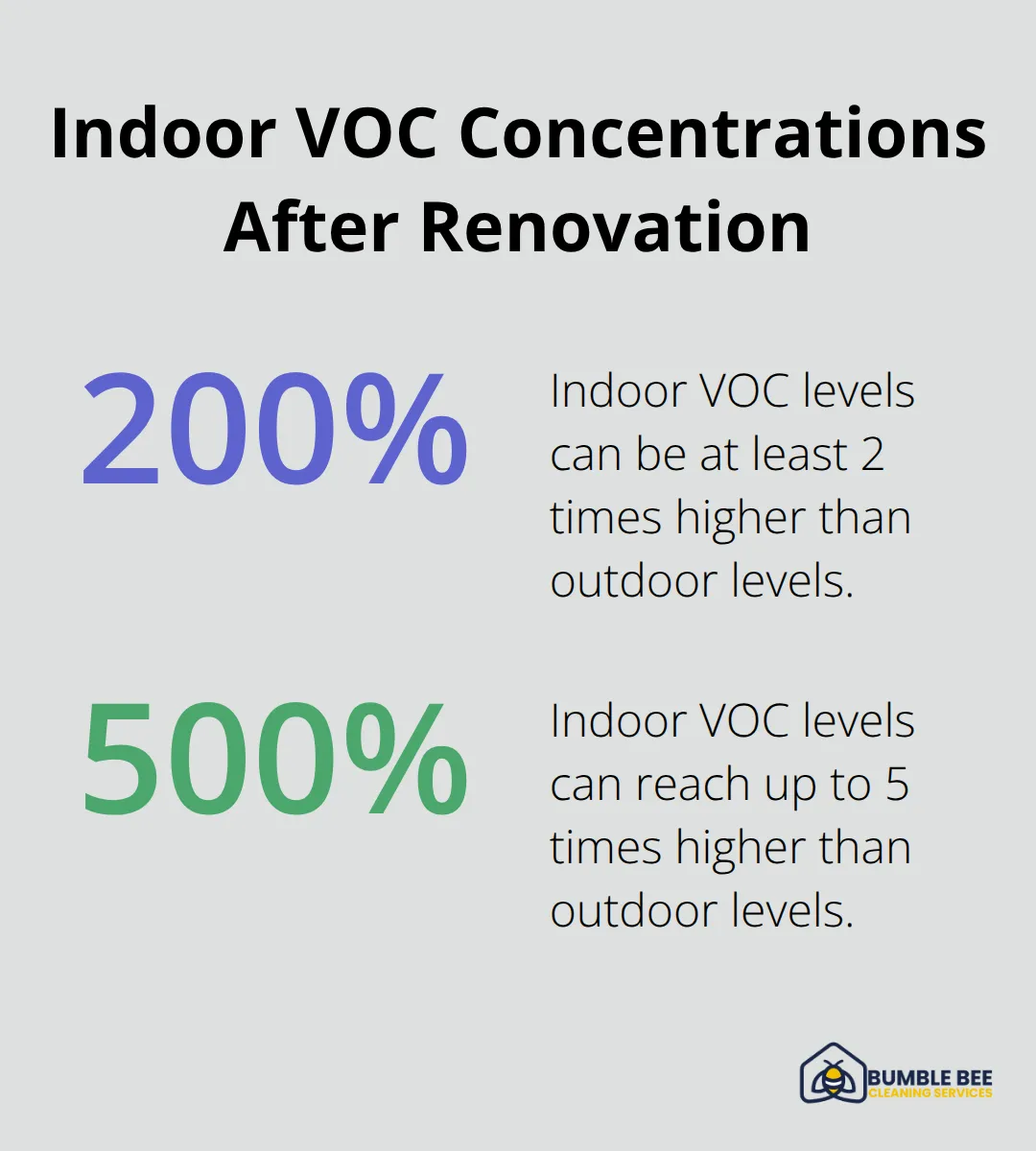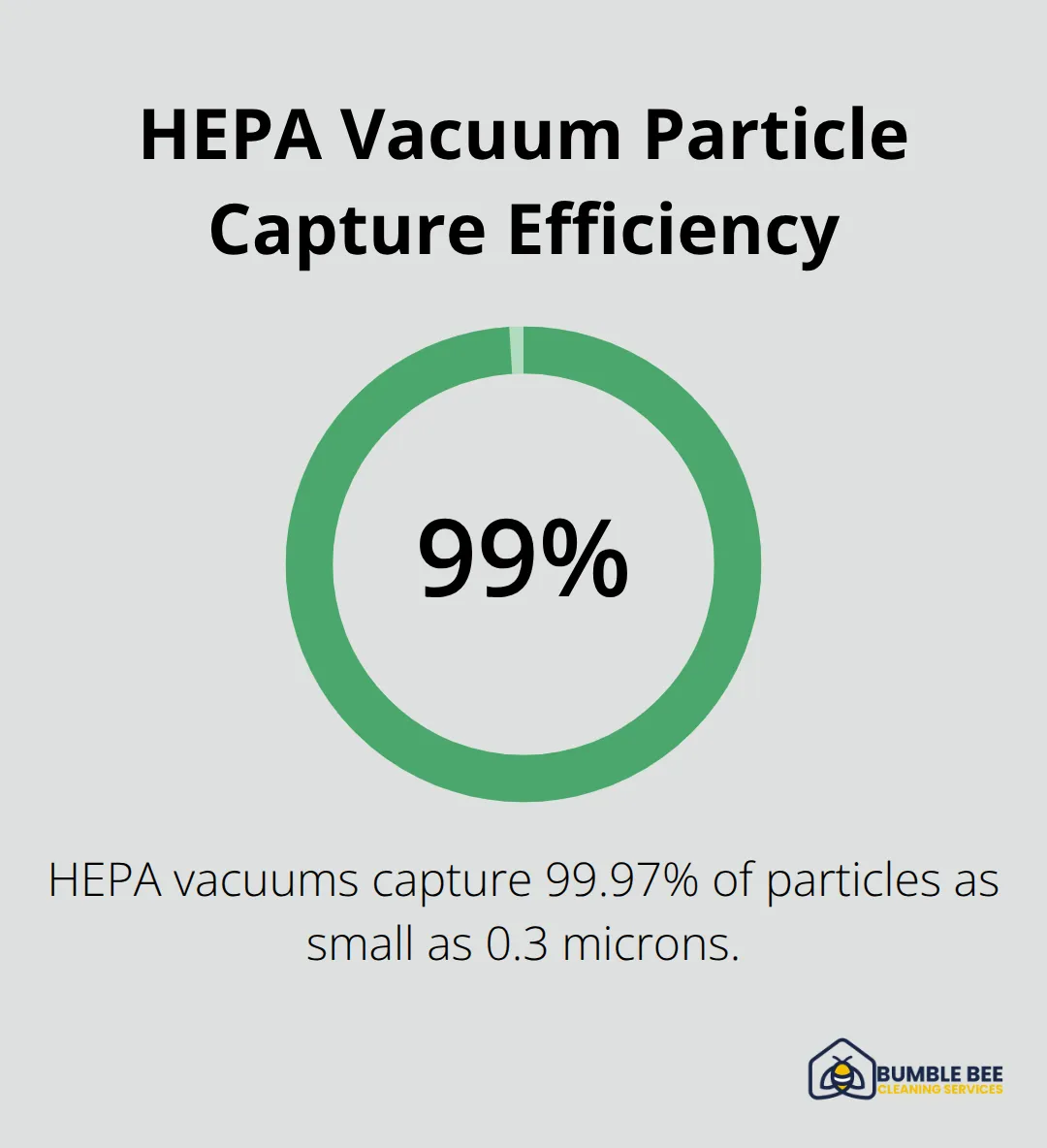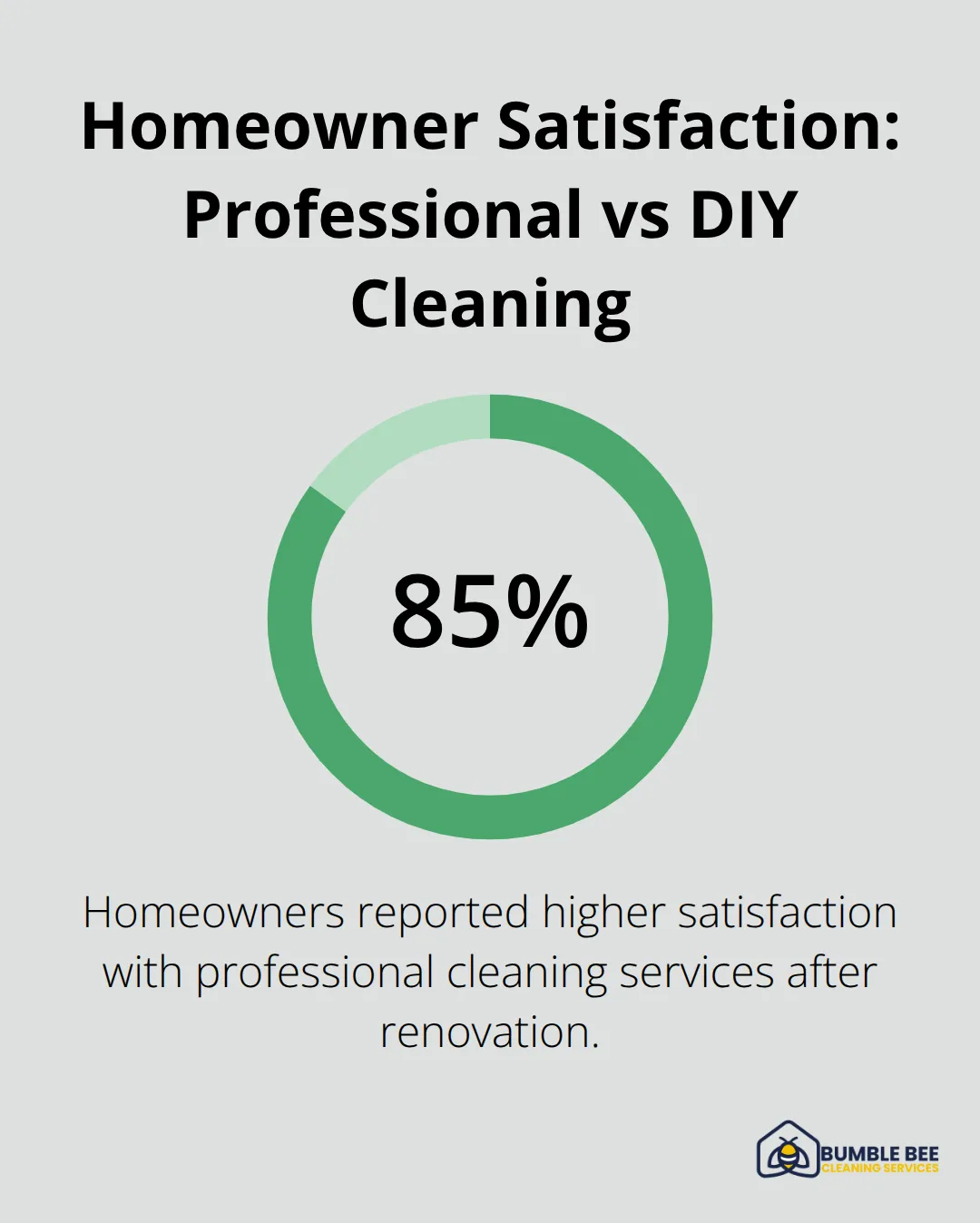Your Seattle home renovation is complete, but post-renovation dust has settled everywhere. This fine debris penetrates every corner, creating health risks and making your space feel far from finished.
We at Bumble Bee Cleaning Services know that standard cleaning methods won’t tackle this specialized mess. You need targeted strategies and professional techniques to restore your home to pristine condition.
What Makes Post-Renovation Dust So Dangerous
Post-renovation dust contains hazardous particles that standard household cleaners cannot handle. Construction dust includes silica from drywall cuts, volatile organic compounds from paint and adhesives, and microscopic debris from sanded surfaces. The Occupational Safety and Health Administration warns that silica exposure leads to lung cancer and chronic obstructive pulmonary disease. Drywall dust particles measure between 0.5 to 100 microns, with the smallest particles that penetrate deep into your lungs and remain airborne for hours.
Construction Dust Health Risks
The Canadian Centre for Occupational Health and Safety reports that construction dust exposure causes serious respiratory issues and potential long-term health problems. Fine particles bypass your body’s natural filters and settle in lung tissue where they trigger inflammation. Volatile organic compounds from fresh paint and materials continue to release toxins for weeks after completion. These substances accumulate in poorly ventilated spaces and create concentrations 2 to 5 times higher than outdoor levels (according to the Environmental Protection Agency).

Why Regular Cleaners Fall Short
Standard vacuum cleaners recirculate fine dust particles through inadequate filters. Regular household cleaners cannot capture particles smaller than 10 microns, which allows dangerous dust to resettle throughout your home. Microfiber cloths trap only surface debris while construction dust embeds deep in carpet fibers, air ducts, and textured surfaces. Professional-grade HEPA vacuums capture 99.97% of particles as small as 0.3 microns, making them essential for effective post-renovation cleanup where standard equipment fails completely.
The Scale of the Problem
Americans spend approximately 90% of their time indoors, where pollutant concentrations can reach dangerous levels after renovations. Construction dust settles into every nook and cranny of your home, from light fixtures to baseboards. The fine particles become airborne with every footstep or air current, continuously recontaminating cleaned surfaces. This persistent dust cycle explains why your home still feels dirty days after you’ve cleaned it multiple times.
The right tools and techniques can break this cycle and restore your home’s air quality.
What Equipment Actually Removes Construction Dust
Professional post-renovation cleanup demands industrial-grade HEPA vacuums that capture 99.97% of particles as small as 0.3 microns. The AlorAir CleanShield HEPA 550 Air Scrubber delivers 550 CFM clean air delivery rate, which makes it one of the most effective options for heavy dust environments. Microfiber cloths trap up to 99% of dust, dirt, and bacteria, which proves their superiority over traditional materials for post-remodel cleanup.
Essential HEPA Equipment Selection
Professional-grade HEPA vacuums remove fine particles that standard household vacuums recirculate back into your air. These industrial units feature sealed systems that prevent dust leakage during operation.

The Honeywell HPA300 provides cost-effective performance at just over $200 with a 300 CFM rating for medium to large spaces. You need equipment that maintains consistent suction power throughout extended cleaning sessions (unlike consumer models that lose effectiveness quickly).
The Top-Down System That Works
Start your cleanup from ceilings with long-handled mops to remove accumulated dust without ladders. Clean walls with damp microfiber cloths and soapy water to capture dust in crevices, working systematically from top to bottom. Use telescoping dusters for hard-to-reach areas like ceiling corners and high fixtures. Vacuum all surfaces including walls, ceilings, and light fixtures with professional-grade HEPA equipment to improve indoor air quality.
Floor-Specific Techniques
Different flooring types require tailored approaches for effective dust removal. Hardwood floors benefit from damp mopping with specific cleaners that won’t damage the finish. Carpets need professional deep cleaning services to extract embedded construction particles from fibers. Tile and grout lines collect fine dust that requires baking soda paste and toothbrush scrubbing for complete removal.
Air Purification Systems
Install MERV-13 or MERV-16 HVAC filters to capture small dust particles effectively (upgrading from standard filters makes a dramatic difference). Run continuous airflow in your HVAC system for the first week post-cleaning to filter airborne dust. Use eco-friendly cleaners certified by Green Seal or EcoLogo for safer family environments. Replace air filters monthly during initial months after construction to catch remaining dust and allergens.
The right equipment handles the technical challenges, but the physical demands and time investment of DIY cleanup often overwhelm homeowners who underestimate the scope of post-renovation cleaning.
Should You Tackle Post-Renovation Cleanup Yourself
DIY post-renovation cleanup demands 8-12 hours for a full home, according to industry data. You’ll spend entire weekends crawling under furniture, climbing ladders to reach ceiling fans, and repeatedly vacuuming the same surfaces as fine dust continues to settle. The physical demands include lifting heavy furniture, working in awkward positions, and wearing protective equipment for hours. Most homeowners underestimate this scope and abandon the project halfway through, leaving dangerous particles throughout their living space.
The Reality of DIY Time Investment
Professional teams complete the same job in 6-8 hours that takes you multiple weekends. You face constant interruptions as dust resettle on surfaces you’ve already cleaned. The systematic approach professionals use prevents this cycle, while DIY attempts often create more work. Your household vacuum lacks the power to extract embedded particles from carpet fibers and upholstery.
Professional Equipment Makes the Difference
Professional post-construction cleaners use industrial-grade HEPA vacuums that remove 99.97% of particles as small as 0.3 microns, while your household vacuum recirculates these hazardous particles back into your air. The National Association of Home Builders found that 85% of homeowners who hired professional cleaning services after a remodel reported higher satisfaction with results compared to DIY attempts.

Professional teams bring specialized equipment that costs thousands of dollars to purchase (equipment most homeowners will never need again after one project).
Cost Analysis Reveals Hidden Expenses
Professional cleaning services charge $0.10 to $0.50 per square foot for post-construction cleaning, making a 2,000 square foot home cost $200-$1,000 depending on renovation complexity. DIY cleanup costs include renting industrial equipment ($150-$300), purchasing specialized supplies ($100-$200), plus your time valued at $25 per hour totals $650-$1,250. Factor in the health risks from prolonged dust exposure and potential damage from improper techniques.
Health Protection Through Professional Expertise
Certified professionals understand which particles pose the greatest health risks and how to remove them safely. They wear proper protective equipment and follow OSHA guidelines for dust exposure. DIY cleaners often skip protective measures or use inadequate equipment, increasing their exposure to silica and other harmful substances. Professional services protect your family’s health while delivering complete dust removal that DIY methods cannot match.
Final Thoughts
Post-renovation dust demands a systematic approach that starts with professional-grade HEPA equipment and follows a top-down sequence. The most effective strategy combines industrial vacuums that capture 99.97% of particles with microfiber cloths and specialized products designed for construction debris. You should call professional services when your renovation involves extensive drywall work, when family members have respiratory sensitivities, or when the cleanup exceeds 2,000 square feet.
Professional teams complete thorough dust removal in 6-8 hours compared to the 20-30 hours required for DIY attempts. You can maintain your dust-free environment after completion by upgrading to MERV-13 HVAC filters and replacing them monthly for the first three months. Run your HVAC system continuously during the first week to capture remaining airborne particles (this prevents dust from resettling on clean surfaces).
We at Bumble Bee Cleaning Services specialize in post-construction cleanup with certified technicians and industrial-grade equipment. Our team has extensive experience with post-renovation dust removal throughout Seattle homes. Contact us today to restore your home to the safe and comfortable environment your family deserves.
